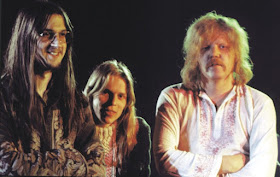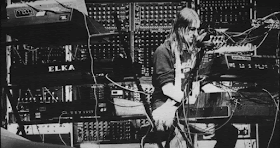[Stratosfear, the last Tangerine Dream album by the great Baumann/Franke/Froese threesome, shows the group's desire to advance past their stellar recent material and stake out a new musical direction while others were still attempting to come to grips with Phaedra and Rubycon. The album
accomplishes its mission with the addition of guitar (six- and 12-string), grand piano, harpsichord, and mouth organ to the usual battery of moogs, Mellotrons, and e-pianos. The organic instruments take more of a textural role, embellishing the effects instead of working their own melodic conventions. Stratosfear is also the beginning of a more evocative approach for Tangerine Dream. Check the faraway harmonica sounds and assortment of synth-bubbles on "3 AM at the Border of the Marsh From Okefenokee" or the somber chords and choral presence of "The Big Sleep in Search of Hades." The title track opener is the highlight though, beginning with a statuesque synthesizer progression before unveiling an increasingly hypnotic line of trance.
Review by John Bush]
[Following the path of increasing symphonic-progressiveness that marked the first six years of Tangerine Dream's Virgin career, "Stratosfear" is the most symphonic-oriented album by Tangerine Dream with Peter Baumann still in the band. The emphasis on the organization of clear melodic lines
and compelling keyboard orchestration is quite clear, while still sticking to the electronic ambience formula that TD learnt to make their own. The title track kicks off the album with grandeur and sheer elegance, introducing a couple of 12 string electric guitar arpeggios over a soft, dreamy keyboard layer once the main motif is introduced on Moogs and mellotron, the listener is hooked into the sequence of gentle variations on synth and lead guitar, somehow reminding them of "Wish You Were Here"- Pink Floyd and "Moon Madness"- Camel.
The closing comeback of the opening theme in a more melancholy mood ends the cycle in order to give the listener room for meditation about the show of ethereal beauty they are presented to. "The Big Sleep in Search of Hades" is also constructed under the main theme/interlude/reprise premise. The opening-closing section is a graceful Baroque-like sonata built upon the dialogue between real harpsichord and mellotron flute; what happens in between is a somber Gothic synth/mellotron string extravaganza, pretty much related to the overall spirit of "Atem" and "Phaedra", though not as harsh.
Once again, pure beauty becomes the rule at writing and performing - this particular number feels stylistically connected to the stuff created by Schicke Führs & Fröehling and Pulsar. Things get
more exotic and cosmic in "3 A.M. at the Border of the Marsh from Okefenokee", whose Arabic-like lines on mellotron brass, synth and electric piano, flowing synth layers, and occasional passages on harmonica manage to convey sonically the situation of having a nice meditative walk by a march before the first light of dawn.
The best track is "Invisible Limits", which is actually structured in a similar way than the opening cut, without the reprising motif in the end. In exchange, after the symphonic tour-de-force conveyed
by the clever interplay of keyboards and guitar, we are first offered a minimalistic succession of random and almost unnoticeable touches of synth and electric piano, then concluding with an astonishingly beautiful nocturne on grand piano, seasoned by a dreamy mellotron flute.
The aggressive handling of the last piano chords serves to release the fire that had been contained for the previous 50 seconds - the appearance of the human heart that all this time had been behind the electronic paraphernalia. Such a brilliant ending is more than appropriate for such an evocative album.
Review by Cesar Inca]
By 1976, Tangerine Dream had established a solid, if enigmatic, reputation as pioneers of stately, glacial and planetary synthesiser music rejecting anything approaching “rock” music: so, ironically, reintroducing an electric guitar to their sonic grab-bag was perceived as a radical step.
The Berlin outfit, founded in September 1967 by Edgar Froese, had made a limited degree of headway in their native Germany and elsewhere in central Europe, but it wasn’t until Richard
Branson signed them to his Virgin imprint in December 1973 – on the stairwell of the Virgin store in Notting Hill – that their shock-of-the-new notoriety spread, firstly with 1974’s "Phaedra" and then 1975’s "Rubycon" (a UK Top 10 album). A Moog modular synthesiser, purchased from Ohr label co-founder Peter Meisel with money from the Virgin advance, contributed in large part to the sequencer pulse which characterised these albums, and a series of concerts in unlikely, rarefied settings, including York Minster and Reims Cathedral, boosted their profile while distancing them from the indignities of the workaday touring circuit.
Stratosfear was to be the last studio album performed by the “classic” Tangerine Dream trio of Edgar Froese, Christopher Franke and Peter Baumann (the latter would leave after the band’s first US tour,
in 1977). Released in October 1976, the album was also the first TD project to be recorded in Audio Studios, situated in Berlin’s Lichterfelde district. The title track is topped and tailed by a circular, gently flanged 12-string guitar pattern (other than bass, Tangerine Dream hadn’t factored a guitar into their sound since 1972’s "Zeit") but the body of the piece features a more urgent yet conventionally structured version of the sequencer burble which underscored much of "Phaedra" and "Rubycon"; a keening, high-register synth line suggests the motifs favoured by Kraftwerk. "The Big Sleep In Search Of Hades", meanwhile, creeps in on an arpeggiated harpsichord figure, dressed with a courtly flute melody, before curdling into a sinister Mellotron wash.
"3AM At The Border Of The Marsh From Okefenokee" again features a textural introduction which recurs at the track’s conclusion: rather surprisingly, a high-plains-drifter harmonica is contrasted with swooping sci-fi drifts of synth and a placid, heart-monitor, C-octave throb. This, in turn, becomes subjugated by a hardscrabble synth blizzard.
The concluding "Invisible Limits" features Froese carefully mapping out a minimal electric guitar solo before a scampering sequencer figure exerts control, itself sinking into an abstract electronic whirlpool. Out of this emerges a simple grand piano-and-flute figure, its chord progression faintly reminiscent of the concluding section of Pink Floyd’s ‘Saucerful Of Secrets’.
With hindsight, Stratosfear was the album which introduced the compelling notion that Tangerine Dream harboured an old-school respect for an enduring melody. The inscrutable knob-twiddlers, capable of enraging uncomprehending listeners to the point where one threw a bag of marmalade at
them at a 1973 Paris concert, had come of age.
One of the earlier albums driven by electronic synthesizers, it is more refined and carefully arranged than similar tracks being released today and maintains its age with grace. Like the other releases by Edgar Froese and company, the album navigates through all kinds of emotions, swerving effortlessly from sprawling, otherworldly harmonies to simple ambience. Using what was available at the time to literally invent sounds, part of Stratosfear’s charm lies not only in its incredibly moving set of pieces, but with an instrument that is less than a decade old, what’s truly incredible is how effortlessly they manage to do so.
The album’s title track pushes us forward and wills us along for the journey, jogging ahead and
willing us to keep pace. "The Big Sleep" lulls and soothes, "3am" gives us a deeper sense of the marshy and mysterious realm, but by sprinting through the finish, "Invisible Limits" (famously sampled in DJ Shadow’s Endtroducing) becomes the most memorable thing on the record. Each track is so separate and distinct, their very own decadent pieces, yet they manage to come together magnificently to tell a beautiful story in supernatural form.
The wandering chords of a soft acoustic guitar meet the mists of a dark mellotron. After a brief introduction of iodized steam, the sequencer introduces a bass and round line whose chords roll like
percussion and waved in a biting rhythm on keyboard chords that merge into a melodious and symphonic synth. The cadence is amplified with subdivided sequences that mold finely feverish percussions, guiding "Stratosfear" towards a superb melodious passage with its ghostly synth. A remarkable passage where one feels the dramatic and mephistolic approach of "Stratosfear" which reaches its melodious apotheosis with strident spectral synth blows.
With its wild rhythm on sequences with subdivided chords and random percussions, "Stratosfear" navigates in troubled waters embracing brief atmospheric passages but always keeping the course on a minimalist rhythmic with fine modulations. Everything is beautifully combed by Edgar Froese's juicy guitar. And the rest is history. "Stratosfear", as well as its title track, will mark the destiny of Tangerine Dream, as much as Stairway to Heaven scored that of Led Zeppelin.
Tangerine Dream – Stratosfear
Label: Virgin – TAND 8, Virgin – 7243 8 40065 2 5, Virgin – 7243 8 40065 25
Series: Tangerine Dream Definitive Edition – TAND 8
Format: CD, Album, Remastered, Reissue
Country: Europe
Released: 27 Feb 1995
First Release: 1976
Genre: Electronic
Style: Experimental, Ambient
TRACKS
1. Stratosfear 10:35
2. The Big Sleep In Search Of Hades 4:26
3. 3 AM At The Border Of The Marsh From Okefenokee 8:49
4. Invisible Limits 11:24
Line-up / Musicians
Edgar Froese: Moog, Mellotron, grand piano, 12- & 6-string guitars, bass, mouth organ
Christoph Franke: Moog, Birotron, organ, harpsichord, percussion
Peter Baumann: Moog, Mellotron, Fender Rhodes, Projekt Electronic rhythm computer
Releases information
The last studio album of this line-up, recorded entirely in a small studio in Berlin 1976.
























So wonderful, thank you!
ReplyDeleteGracias! ojalá también pudieras compartir el album Rubycon :)
ReplyDelete